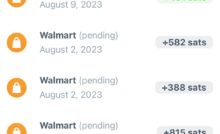Aggregate Bitcoin Price Has Increased By $87 Billion In Last Five Months
The realized market capitalization of bitcoin, or aggregate price paid for every coin on the network, increased by $87 billion since last August.
The below is from a recent edition of the Deep Dive, Bitcoin Magazine’s premium markets newsletter. To be among the first to receive these insights and other on-chain bitcoin market analysis straight to your inbox, subscribe now.
In recent weeks, much of our analysis has been focused on the consolidation period currently occurring in the bitcoin market, with a particular focus on realized price as an indicator of lackluster capital flow. As shown by the chart below, the realized market capitalization of bitcoin, which can otherwise be thought of as an aggregate price paid for every coin on the network, has increased by $87 billion since the beginning of August.
While significant in absolute terms, given that the realized market capitalization of bitcoin was a mere $90 billion at its peak following the 2017 bull market, in relative terms realized cap has not meaningfully increased since early fall of 2021.
A look at the 30-day rate of change of realized price gives additional context to this dynamic.
To dig deeper into the dynamic of price and realized price, we can examine the Delta Gradient indicator. The metric gauges market momentum relative to capital inflows.
As per Glassnode,
“The momentum of a market can be considered by assessing the rate of change of price, or the verticality over some period. The simplest example is a parabolic advance, whereby the rate of price appreciation increases in magnitude as a result of market momentum.
“The Realized Price reflects the aggregate price at which each coin in the supply last moved. Steeper increases in the Realized Price indicates a true and organic capital inflow is occurring, as every coin that is spent on-chain and sold, has a buyer with fresh capital. The steepness of this curve therefore represents a rational baseline for sustainable value growth.
“The Delta Gradient is calculated as the difference between the gradient of the spot Price, and the gradient of the Realized Price. This metric therefore measures the relative change in momentum between speculative value, and true organic capital inflows.
“Statistical normalization is then applied to bring historical values, and log-scale price changes into a consistent scale.”
The realized market capitalization of bitcoin, or aggregate price paid for every coin on the network, increased by $87 billion since last August.
The below is from a recent edition of the Deep Dive, Bitcoin Magazine’s premium markets newsletter. To be among the first to receive these insights and other on-chain bitcoin market analysis straight to your inbox, subscribe now.
In recent weeks, much of our analysis has been focused on the consolidation period currently occurring in the bitcoin market, with a particular focus on realized price as an indicator of lackluster capital flow. As shown by the chart below, the realized market capitalization of bitcoin, which can otherwise be thought of as an aggregate price paid for every coin on the network, has increased by $87 billion since the beginning of August.
While significant in absolute terms, given that the realized market capitalization of bitcoin was a mere $90 billion at its peak following the 2017 bull market, in relative terms realized cap has not meaningfully increased since early fall of 2021.
A look at the 30-day rate of change of realized price gives additional context to this dynamic.
To dig deeper into the dynamic of price and realized price, we can examine the Delta Gradient indicator. The metric gauges market momentum relative to capital inflows.
As per Glassnode,
“The momentum of a market can be considered by assessing the rate of change of price, or the verticality over some period. The simplest example is a parabolic advance, whereby the rate of price appreciation increases in magnitude as a result of market momentum.
“The Realized Price reflects the aggregate price at which each coin in the supply last moved. Steeper increases in the Realized Price indicates a true and organic capital inflow is occurring, as every coin that is spent on-chain and sold, has a buyer with fresh capital. The steepness of this curve therefore represents a rational baseline for sustainable value growth.
“The Delta Gradient is calculated as the difference between the gradient of the spot Price, and the gradient of the Realized Price. This metric therefore measures the relative change in momentum between speculative value, and true organic capital inflows.
“Statistical normalization is then applied to bring historical values, and log-scale price changes into a consistent scale.”
Bitcoin Magazine: Bitcoin News, Articles, Charts, and Guides
Recent Posts
Crypto Analyst Predicts 1,500% Pump As Litecoin Grows Against Bitcoin
Litecoin has been gaining momentum in recent weeks, and according to crypto analyst Tony “The…
U.S.-Listed Bitcoin Miners Are Growing Their Share of the Network Hashrate: Bernstein
Bitcoin (BTC) miners listed in the U.S. are growing their share of the network hashrate,…
Metaplanet Spends Another $26M Buying Bitcoin, Lifting Holdings Above 2K BTC
Metaplanet (3350) said it bought a further 269.43 bitcoin (BTC), strengthening its position as a…
U.S. Crypto Task Force to Focus on Delivering National Bitcoin Reserve: Bernstein
The U.S. crypto task force will focus on starting up a national bitcoin (BTC) reserve,…
In a Lethargic Bitcoin Market, BTC $110K Option Play Emerges as Top Trading Strategy
Bitcoin (BTC) has been relatively listless this month, hunching below $100,000. However, this hasn't deterred…
Bitcoin Whales Accumulate—Will This Push BTC Toward $100K?
Changing macroeconomic conditions and big investment activity are driving Bitcoin near the crucial $97,000 resistance…


